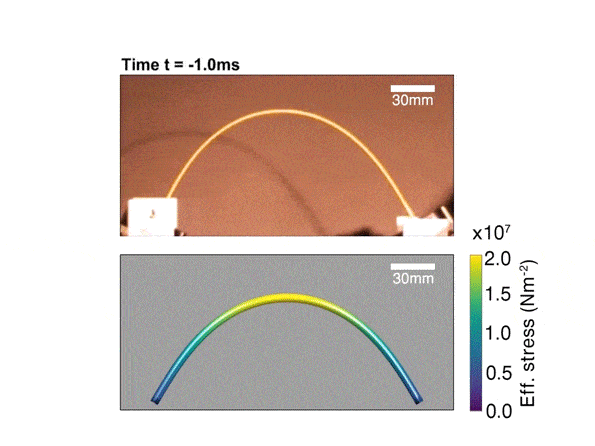Here’s an experiment: grab a dry spaghetti noodle on both ends. Bend it more and more, until it breaks. Intuitively, you’d think it breaks into two pieces, but that’s almost never the case — it typically breaks into 3 or 4 different pieces. Try again and again, as many times as you want, you’ll likely never end up with two pieces.

The Spaghetti Conundrum
If that confuses you, don’t worry — you’re in good company. This spaghetti conundrum has flummoxed scientists for decades. Even the renowned and ever-curious physicist Richard Feynman was fascinated by this. By his own account, he spent the better part of an afternoon breaking spaghetti in halves and wondering why they don’t snap in two. He couldn’t come up with a satisfying explanation, and the mystery remained unsolved until 2005 when physicists from France came up with a working theory.
They found that when a spaghetti — and for that matter, any long rod — is bent at the ends, it will break near the center, where it is most curved. But as it breaks, triggers a “snap-back” effect, producing a bending wave, or vibration, which further breaks the rod. The theory was demonstrated, and as a reward for their trouble, the French physicists received an Ig Nobel Prize, a parody of the Nobel Prize, which celebrates unusual or trivial findings.
But even after this, a question remained: is it never possible to break a spaghetti in two? The answer is ‘yes’, with a twist — as in if you twist them, you can break them in only two. In a paper published this week in the Proceedings of the National Academy of Sciences, researchers report that if you also twist the spaghetti, this dampens the shock wave and reduces the chance of breaking into several pieces. Essentially, if a stick is twisted past a critical degree, then slowly bent in half, it will break in two.
However, researchers say, this could have far-reaching implications, going way beyond culinary curiosities. The findings could be used to control fractures and increase toughness in rod-like materials such as multifiber structures, engineered nanotubes, or even microtubules in cells.
“It will be interesting to see whether and how twist could similarly be used to control the fracture dynamics of two-dimensional and three-dimensional materials,” says co-author Jörn Dunkel, associate professor of physical applied mathematics at MIT. “In any case, this has been a fun interdisciplinary project started and carried out by two brilliant and persistent students — who probably don’t want to see, break, or eat spaghetti for a while.”

Pasta maths
The two students Dunkel is referring to are Ronald Heisser, now a graduate student at Cornell University, and Vishal Patil, a mathematics graduate student in Dunkel’s group at MIT. Their co-authors are Norbert Stoop, instructor of mathematics at MIT, and Emmanuel Villermaux of Université Aix Marseille. They designed a device that can controllably bend and twist spaghetti ends, focusing on two types of spaghetti: Barilla No. 5 and Barilla No. 7, which have slightly different diameters.
“They did some manual tests, tried various things, and came up with an idea that when he twisted the spaghetti really hard and brought the ends together, it seemed to work and it broke into two pieces,” Dunkel says. “But you have to twist really strongly. And Ronald wanted to investigate more deeply.”
Meanwhile, Patil developed a mathematical model to explain this behavior, building on the previous work done by French scientists Basile Audoly and Sebastien Neukirch, who first studied this behavior. Putting all the hard work together, they finally solved this unusual puzzle — but there is one caveat.
Their study works on the assumption of cylindrical shapes — in other words, it only works for “classic” pasta. Other types of pasta, like fussili or linguini will have a different behavior because they also have a different geometry.
The study has been published in PNAS.


